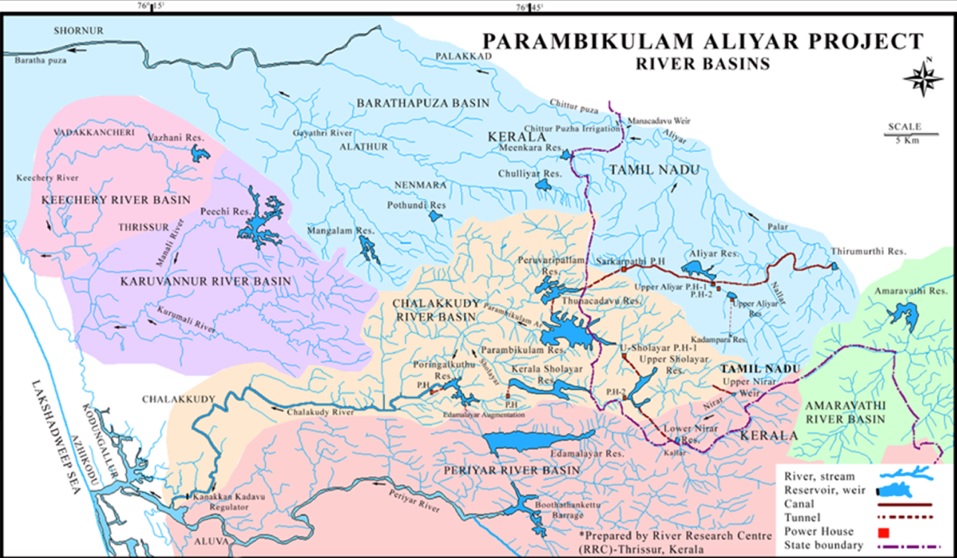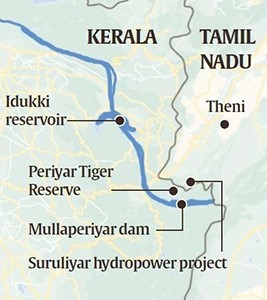What is the issue?
The issue of the maximum water level in the Mullaperiyar dam and the possibility of a dam-break has revived the contyroversy surrounding the Tamilnadu Kerala relations.
What is the history of the Mullaperiyar dam?
- The 130-year old Mullaperiyar dam is located on the confluence of the Mullayar and Periyar River in Kerala’s Idukki district.
- It was built by Pennycuick to create a harmonious atmosphere in the east coast by taking the water there and have people cultivate crops.
- Although the dam is located in Kerala, it is operated by Tamil Nadu following an 1886 lease indenture for 999 years that was signed between the Maharaja of Travancore and the Secretary of State for India.
What is the genesis of the dispute?
- In 1979, a problem erupted over the safety of the dam which led to a tripartite meeting that decided to bring the water level from the full reservoir level of 152 ft to 136 ft.
- By mid-1990, Tamil Nadu started demanding restoration of the water level in the Mullaperiyar as it had completed the dam strengthening works.
- When no consensus was reached through negotiations, the Supreme Court was approached.
- The Supreme Court in February, 2006 allowed Tamil Nadu to raise the water level of the dam to 152ft.
- In response to that,Kerala government enacted Irrigation and Water Conservation (Amendment) Act, 2006 and put the second schedule of Mullaperiyar Dam as endangered and fixed its maximum water level to 136ft.
- In 2014, the apex court declared the Act unconstitutional and restrained Kerala from interfering with the rights of Tamil Nadu in raising the water level in the dam to 142 feet.
- The Kerala government has been at many times emphasising the urgent need for the gradual release of water.
What is the standpoint of Kerala government?
- Dam safety- The Mullaperiyar dam suffers from structural issues and the possibility of a dam-break cannot be ruled out.
- The dam is located in an earthquake-prone area and small-time earthquakes that had happened in 1979 and 2011 caused some cracks in the dam.
- The leakage in the dam is another cause of concern.
- The technology which was put into use for constructing the dam 130 years ago was obsolete compared to the sophisticated construction methods used now.
- According to the UN University report, 35 lakh people in Kerala will be directly hit in the case of a dam-break.
- It will also have its impact on the National Periyar Park which hosts some of the endangered species.
What is TamilNadu’s position regarding the dispute?
- For Tamil Nadu the Mullaperiyar dam is like a lifeline for the people of Madras Presidency for irrigation and drinking
- The dam is also significant for the generation of the power in lower Periyar water station as the region is is shadow and arid.
- So, the government of Tamil Nadu insists on raising the water level in the dam pointing out the failure of crops.
- The government has also asserted that it has full right over the control of the dam.
- Tamil Nadu has challenged the Kerala’s proposal for decommissioning of the dam and construction of a new dam.
What are the other river water issues between both the states?
- An element of uneasiness is present in the ties between Tamil Nadu and Kerala on the subject of water which is far more complex than those of Tamil Nadu with Karnataka.
- Parambikulam-Aliyar, Siruvani of the Bhavani sub-basin, Neyyar, and the proposal for linking the Pamba and Achankovil rivers of Kerala with Vaippar of Tamil Nadu,etc. are the issues.
What is the Parambikulam-Aliyar Project issue?

- The project was signed between Tamil Nadu and Kerala in 1970 with retrospective effect from November 1958 to divert and integrate 8 West flowing rivers - 6 in the Anaimalai Hills and 2 in the plains .
- The objective is to benefit the drought prone areas in the Coimbatore and Erode district of Tamilnadu State and to stabilize the existing irrigation system in Chittoorpuzha of Kerala State.
- The agreement ensures Kerala’s riparian share in the Sholayar and Chittoorpuzha sub-basins as a guaranteed annual entitlement without applying the distress-sharing formula.
- It also ensures four months’ flow (from the Northeast monsoons) from the Upper Nirar weir for Kerala’s exclusive use in the Periyar basin.
- The agreement provides for review every 30 years since November 9, 1958 but it remains inconclusive.
- Kerala’s concerns - Kerala has reservations on the non-realisation of its share of 2.5 tmc of water from the Parambikulam group of rivers for the exclusive use of Chittoorpuzha valley.
- Construction of some structures in the project area without Kerala’s concurrence ia another area of concern.
- Tamil Nadu’s stand - It has proposed new constructions to augment its share — the Nirar-Nallar Project and Balancing Reservoir above Manacadavu for which Kerala has not consented.
- In the last 20 years, the Chalakudy basin experienced overflow in 12 years and a sizeable portion of the water is also lost as unutilisable flows.
- The way forward lies in trapping the existing spill at Chalakudy and Bharathappuzha through new reservoirs.
What are the provisions for distribution of water in Indian Constitution?
- Entry 17 in the State List – It makes water a state subject.
- Entry 56 in the Union List – The Central Government is conferred with powers to regulate and develop inter-State rivers to the extent declared by the Parliament by law to be expedient in the public interest.
- Article 262 – It provides that Parliament may adopt legislation for the settlement of disputes or complaints concerning the transboundary waters in a river or river valley.
What is the need of the hour?
- Kerala must give its permission for completing the remaining works to strengthen the dam at the earliest.
- Tamil Nadu should ensure that all the instruments for monitoring the safety and health of the dam are installed and are functioning properly.
- Both the players should adopt a rational approach while deciding on the storage levels and safety aspects of the dam.

